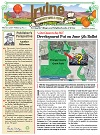On the evening of Tuesday, May 24th, the Irvine Unified School District (IUSD) held what they surely consider the last Board meeting to consider the contamination at the Portola High School (PHS) site. The Department of Toxic Substances Control (DTSC) made their presentation supporting PlaceWorks’s recommendation that “no further action is required.” So, although no further investigation or cleanup is required by law, the debate over what level of each Volatile Organic Compounds (VOCs) is safe is not settled. For example, we now know there are no safe levels for benzene and toluene. And, the source(s) of the contamination is still not known, only hypothesized. Below is a synopsis of relevant events:
The map on this page shows how few locations were actually tested for the toxic VOCs that are dangerous to human health. When IUSD, their environmental consultant PlaceWorks and the DTSC make presentations, they always show a map loaded with dots, squares and circles that are irrelevant, having nothing to do with the useful locations where soil-gas testing was performed. They only obfuscate the truth. And there are 17 test locations rather than 10 only because of a resident uprising at the March 22nd Board meeting that demanded more testing.

The only reason the recent set of soil-gas tests was performed, was because of a letter former Mayor Larry Agran sent to Governor Brown on August 31, 2015, with supporting evidence provided by Dr. Liss demonstrating that the school site (at the end of runways) was likely used by the military, probably to dispose of used solvents and other toxic fluids. Thus, the site likely did not always only serve agricultural purposes, as it was previously portrayed by PlaceWorks and approved by DTSC in 2014.
How did Agran’s August 31, 2015 letter lead to testing of the site interior? Months after Agran’s letter arrived at the Governor’s desk, after many communications between Dr. Liss and DTSC Division Chief Dot Lofstrom, a remarkable set of orders in a March 2, 2016 letter from DTSC Director Barbara Lee, on behalf of CalEPA Secretary Matthew Rodriquez, was sent to the IUSD. That letter overturned the previous assessment made by PlaceWorks, that the school site was always used only for agricultural purposes, and agreed with Dr. Liss that the site likely had military use.
The previous, agricultural-usage only assessment did not impose the requirement to test the site interior for soil-gas VOCs. Thus, the State’s March 2nd letter declared that PlaceWorks was wrong and the DTSC’s approval in 2014 was also wrong in certifying that “further assessment of the site is not required.” The State’s orders now required testing of the interior of the site for VOCs — testing that had NEVER before been performed — regardless of the incessantly repeated, misleading statements that such testing had been performed.
The recent test results from the 17 soil-gas test wells show measurable VOCs in all 17 test wells! Yet, the “Final Characterization Report” produced by PlaceWorks assumes, without evidence, that the unknown contamination levels under the buildings are not higher than those elsewhere on the site. So, PlaceWorks apparently crafted a theory — again without providing any evidence — that the site contamination was caused by IRWD’s recycled water used for irrigation when the site had been used for agriculture. Thus, the contamination under this theory would be uniformly low over the large, untested portions of the site, as well.
Recycled Water? But the use of contaminated recycled water [that IRWD denies] doesn’t explain how the massive soil contamination discovered in a storm-drain trench along Irvine Boulevard occurred; or, how massive contamination occurred in the Agua Chinon, 250 feet to the west of the school site, and could occur elsewhere on the site. In fact, at the top of the above map is a label that reads “40 feet apart” indicating the distance between the massive soil contamination found in the storm-drain trench and the soil-gas test well 37 (SG-37) in which none of the major contaminants of the storm-drain trench were found. The obvious conclusion is that much more intensive testing is required to ensure that the levels under school buildings are not higher. Widely-spaced test locations won’t tell the whole story.
Water-vapor Barrier: PlaceWorks also claims that the 15-mil water-vapor barrier installed under the buildings will protect against VOCs intrusion. Although IUSD could have installed a membrane that is impermeable to VOCs, the installed barrier is not. Moreover, to be protective against VOCs intrusion into the buildings and classrooms, all seams must be welded rather than overlapped and taped as was done at Portola High School. In addition, utility penetrations of the barrier membrane (e.g., sewer lines) must be carefully sealed.
More contamination found: PlaceWorks’s recently-released “Final Characterization Report” revealed a previously unknown-to-the-public discovery of more contaminated soil on the school site while building a retaining wall sometime in 2015, near the storm-drain trench along Irvine Boulevard. This is where massive amounts of contaminated soil had been previously removed with the claim that it has all been removed.
- What is a Cello Madness Congress? - May 5, 2022
- Meet Irvine Resident & Young Filmmaker Ethan Chu - January 11, 2022
- Is the Long-Promised State Veterans Cemetery in Irvine Dead? ABSOLUTELY NOT! - August 8, 2021



